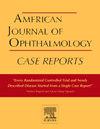与牛角毛藻相关的真菌性角膜炎:一例体内共聚焦显微镜发现的罕见病例报告
Q3 Medicine
引用次数: 0
摘要
目的爪人黄毛藻(yocrenchaeta unguis-hominis)是一种罕见的真菌病原体,通常从皮肤和指甲感染中分离出来。最近,它已被确定为真菌性角膜炎的原因,特别是在隐形眼镜佩戴者中。本病例报告记录了奥地利发生的牛角原火毛藻角膜炎,并使用体内共聚焦显微镜(IVCM)观察角膜基质的变化。患者女,48岁,长期配戴软性隐形眼镜后,左眼出现严重畏光和急性疼痛。初步检查发现角膜中央浸润。在角膜刮痧前进行IVCM,然后送去直接染色、培养和下一代测序(NGS),并鉴定出棘球绦虫和口腔链球菌。治疗包括每小时外用2%伏立康唑,5%纳他霉素和2.5%万古霉素,同时进行额外的上皮清创以增强药物渗透。IVCM成像允许实时可视化和跟踪真菌菌丝外观的结构,指导治疗过程。几个月后,IVCM显示这些结构减少,患者的病情稳定,角膜清晰度和最佳矫正距离视力从0.8提高到0.9 (Snellen十进制刻度)。结论和重要性:本病例对与牛角原火毛藻相关的角膜炎的有限临床文献做出了贡献,包括这种罕见感染的角膜IVCM成像。虽然IVCM提供了间质变化的早期、无创可视化,但通过分子检测获得了明确的诊断。局部抗真菌药物和上皮清创的保守治疗方案是有效的,强调了快速诊断和靶向治疗在治疗罕见角膜感染中的重要性。本文章由计算机程序翻译,如有差异,请以英文原文为准。
Pyrenochaeta unguis-hominis-associated fungal keratitis: A rare case report with in vivo confocal microscopy findings
Purpose
Pyrenochaeta unguis-hominis, also known as Neocucurbitaria unguis-hominis, is a rare fungal pathogen typically isolated from skin and nail infections. Recently, it has been identified as a cause of fungal keratitis, particularly among contact lens wearers. This case report documents the occurrence of Pyrenochaeta unguis-hominis keratitis in Austria and the visualization of changes in the corneal stroma using in vivo confocal microscopy (IVCM).
Observations
A 48-year-old female patient presented with severe photophobia and acute pain in her left eye, following extended wear of soft contact lenses. Initial examination revealed a central corneal infiltrate. IVCM was performed prior to corneal scraping, which was then sent for direct staining, culture, and next-generation sequencing (NGS) and identified Pyrenochaeta unguis-hominis and Streptococcus oralis. Treatment included hourly topical voriconazole 2 %, natamycin 5 % and vancomycin 2.5 %, with additional epithelial debridement to enhance drug penetration. IVCM imaging allowed for real-time visualization and tracking of structures with the appearance of fungal hyphae, guiding the treatment course. Over several months, IVCM demonstrated a reduction in these structures, and the patient's condition stabilized, resulting in improved corneal clarity and Best Corrected Distance Visual Acuity from 0.8 to 0.9 (Snellen decimal scale).
Conclusions and importance
This case contributes to the limited clinical literature on Pyrenochaeta unguis-hominis-associated keratitis and includes IVCM imaging of a cornea with this rare infection. While IVCM provided early, non-invasive visualization of stromal changes, definitive diagnosis was achieved through molecular testing. A conservative treatment regimen with topical antifungals and epithelial debridement was effective, emphasizing the importance of rapid diagnostics and targeted therapy in managing rare corneal infections.
求助全文
通过发布文献求助,成功后即可免费获取论文全文。
去求助
来源期刊

American Journal of Ophthalmology Case Reports
Medicine-Ophthalmology
CiteScore
2.40
自引率
0.00%
发文量
513
审稿时长
16 weeks
期刊介绍:
The American Journal of Ophthalmology Case Reports is a peer-reviewed, scientific publication that welcomes the submission of original, previously unpublished case report manuscripts directed to ophthalmologists and visual science specialists. The cases shall be challenging and stimulating but shall also be presented in an educational format to engage the readers as if they are working alongside with the caring clinician scientists to manage the patients. Submissions shall be clear, concise, and well-documented reports. Brief reports and case series submissions on specific themes are also very welcome.
 求助内容:
求助内容: 应助结果提醒方式:
应助结果提醒方式:


